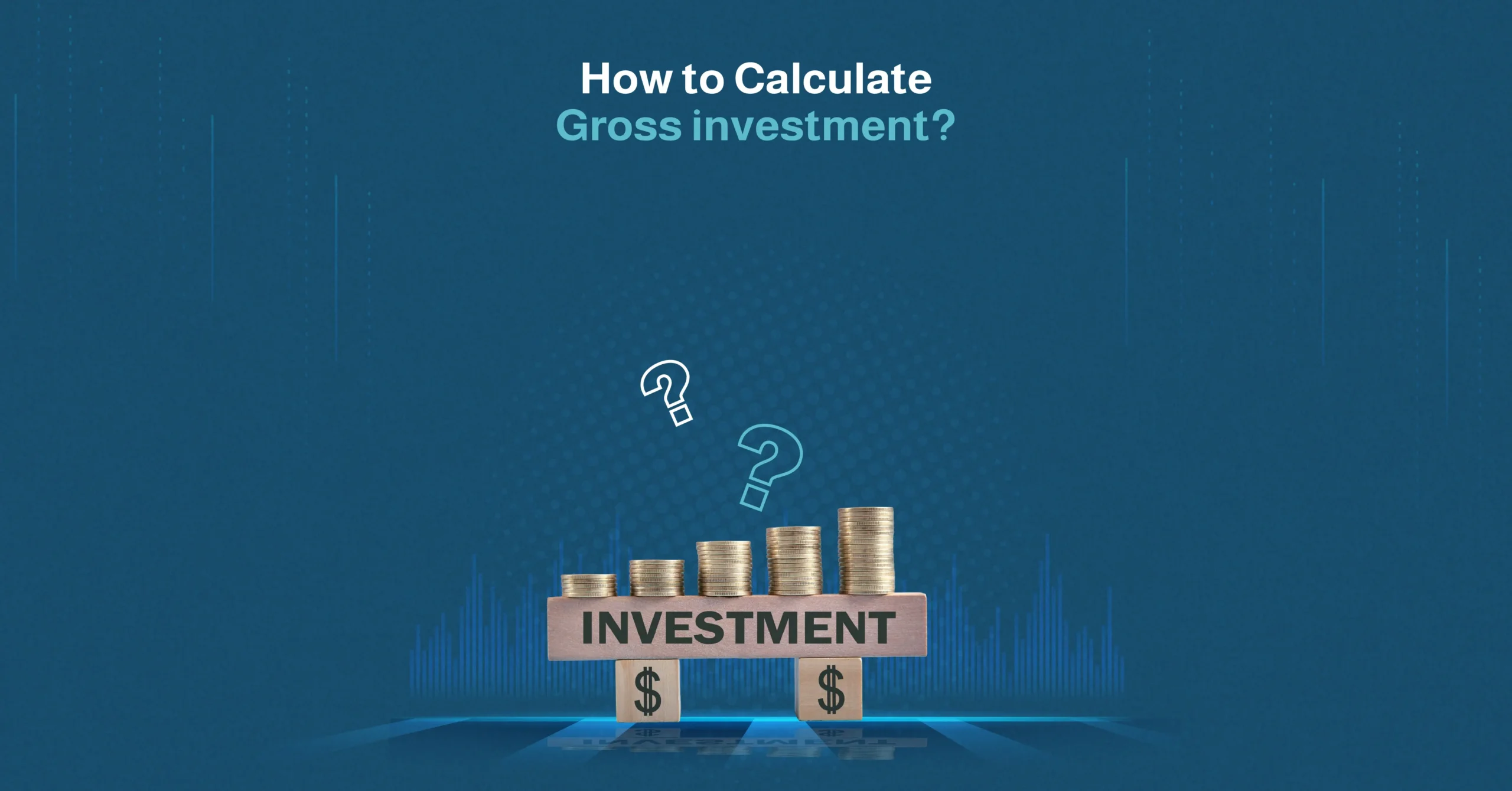The term gross investment is one you hear, but do you truly know what it is? No matter whether you are an economics student, an aspiring investor, or just curious about how economies grow. Understanding how to calculate gross investment is a valuable skill. This concept is vital for both decision-making and national economic planning, as it helps measure the resources committed to building future capacity.
Gross investment represents so much more than just an equation; it is representative of the total amount spent on acquiring new capital assets and replacing those that have worn out. This could be machinery in a factory or infrastructure in a city. Regardless of which, it is a measure of how much is being invested to keep operations running and drive future growth.
We are witnessing global markets shift and adapt to technological changes and evolving economic conditions. By knowing how to calculate gross investment, you can make smarter, data-driven decisions in your personal investment journey or for your business. It is a crucial metric for understanding economic trends in regions such as the MENA, where investment activity plays a significant role in long-term development.
We will be having a closer look at what gross investment means, exploring its key components, and showing you exactly how to calculate it step-by-step, and look at some common mistakes.
More topics can be read on the Gamma blog
What Is Gross Investment and Why It Matters
Imagine you buy a factory that needs some work, with some of the machinery in need of replacement. The total money spent is the gross investment. Gross investment includes capital spent on acquisitions of new assets and replacing those that depreciate over time. These purchases can include machinery, buildings, infrastructure, and changes in inventory levels. This is used as a broad measurement to capture all investment activity before accounting for wear and tear or asset depreciation.
An understanding of how to calculate gross investment is paramount, as it reflects the scale of economic activity along with the resources committed to maintaining and expanding productive capacity. For businesses, it shows how much is being reinvested to sustain growth and competitiveness. For governments and economists, it is an indicator of future economic performance; the higher levels of gross investment can often signal confidence in continued expansion.
Gross investment is important on both a micro and macro scale. For a company, it can influence operational capacity, productivity, and long-term profitability. For a country, it feeds directly into the calculations of Gross Domestic Product (GDP) along with economic growth rates.
While the world around us continues to evolve, economies are having to navigate new technology, changing trade patterns, and evolving customer demand, which is why it is so important that you know how to calculate gross investment and understand how to apply it. It will inform financial decisions and provide insight into the health and direction of an economy.
Components of Gross Investment: Understanding the Basics
We are going to break down the concept into 3 core components to ensure we have a thorough understanding of how to calculate gross investment, as it is not just a single figure. Gross investment is made up of several categories that together reflect total resources committed to maintaining and growing productive capacity.
The three main components are:
| Component | Definition | Examples | Role in Calculation |
| Fixed Investment | Spending on long-term physical assets that contribute to production capacity. | Factory equipment, office buildings, transportation infrastructure. | Forms the largest share of gross investment and directly impacts productivity. |
| Inventory Investment | Changes in the stock of goods held for future sale or production | Raw materials, finished goods awaiting sale. | Shows whether production is increasing or decreasing relative to demand. |
| Replacement capital | Expenditure on replacing worn-out or outdated assets. | Upgrading old machinery, replacing vehicles. | Ensures operations continue without loss of efficiency or output. |
All these components need to be taken into consideration when working out how to calculate gross investment. Fixed investment and replacement capital often come from capital expenditure budgets, while inventory changes are typically drawn from stock reports.
With an understanding of each part, you can make sure that your calculations are complete and reflect both current activity and future potential. This information is useful to students learning economic theory and to investors assessing real-world opportunities.
Step-by-Step Guide on How to Calculate Gross Investment
We will take a look at the formula so we can learn how to calculate gross investment and see how to apply it to real-world scenarios. There are two methods to calculate gross investment, depending on the data you have available.
Formula 1:
Gross investment = Net investment + Depreciation
Formula 2:
Gross investment = Fixed investment + Inventory Investment + Replacement Capital.
We will take a closer look at a step-by-step process:
Step 1: Gather your data
Collect your figures for capital expenditure, inventory changes, and depreciation. These can be found in the business’s financial statements, national accounts, or sector reports.
Step 2: Apply the Formula
- If you know the net investment and depreciation, use the first formula to calculate gross investment.
- If you have details for each component, the fixed, inventory, and replacement, then use the second formula.
Step 3: Work through an example (Business level)
Let’s imagine that a manufacturing company spends $1,200,000 on new machinery and spends $ 300,000 replacing old equipment. Its inventory increases by $50,000.
Gross investment = $1,200,000 + $ 300,000 + $50,000 = $1,550,000
Step 4: Work through an example (National level)
We need to think a little bigger for the national level example. A country’s net investment for the year is $400 billion, with depreciation estimated at $50 billion.
Gross Investment = $400 billion + $50 billion
Step 5: Interpret the results
Higher gross investment is usually a sign that there is economic growth and expansion, while lower figures may point to stagnation or reduced confidence.
It is easy to learn how to calculate gross investment using the provided steps, which will, in turn, help you make more informed decisions.
Common Mistakes to Avoid When Calculating Gross Investment
Even when you fully understand how to calculate gross investment, there can still be the occasional error, which would lead to inaccurate results and possibly flawed decision-making as a consequence. Avoiding these mistakes will mean your figures will remain accurate, reliable, and most importantly, usable in decision-making processes.
- Confusing gross investment with net investment
Gross investment refers to the full amount spent on capital assets before subtracting depreciation, while net investment only accounts for the increase in assets. Results will be distorted if these figures are mixed up.
- Ignoring depreciation
Depreciation is the decline in value of an asset over time. If you were to skip this in your calculations, you would underestimate the total resources committed.
- Overlooking inventory changes
The inventory levels reflect short-term production adjustments. If you were to avoid adding these to your sum, it would make your gross investment appear lower than it is in reality.
- Misclassifying expenses
The operational costs, which would include rent or salaries, are not investments. Only capital expenditures and inventory changes should be included in the calculations.
Being aware of these common mistakes will hold you in good standing, ensuring that your calculations are truly reflective, accurate, comparable, and meaningful for your analysis.
Using Tools Like Gamma Assets to Track Your Investments
While it is important to know how to calculate gross investment, keeping track of the numbers over a period of time is of great importance, too. For business and individual investors alike, accurate data collection makes it so much easier to make informed decisions, and for this, we have technology.
You can manually track data using spreadsheets, but this would only be feasible for small-scale calculations, and even then is prone to errors and requires constant work through updates.
Platforms like Gamma Assets use trackers to help manage real-world assets-backed investments accurately. The platform logs purchases, monitors depreciation, and records changes in inventory, ensuring all components of gross inventory are captured for your convenience.
It doesn’t matter whether you are analysing your personal portfolio or assessing national economic indicators; using the right tools will greatly reduce the risks of miscalculations. Understanding how to calculate gross investment, along with reliable tracking software, can make all the difference in making better-informed financial decisions.
We have come to see that Gross investment is more than just a vague economic term, but is rather a practical equation to measure the amount committed to maintaining and expanding productive capacity. With an understanding of how to calculate gross investment, you will be able to see not only individual purchasing but the full scope of economic activity, too.
The ability to measure and track gross investment accurately in 2026 will be a crucial skill with the market’s constant evolution. If you are a student just starting to learn the basics or an investor managing your assets, or even an economist analyzing trends, the application of this knowledge can help improve decision-making.
You can start investing now from the Gamma Asset Investment Platform
FAQ
What is the difference between gross and net investment?
Gross investment is the total amount spent on new capital assets, including replacements. Net investment is the increase in assets after subtracting depreciation. If we look at an example where $500,000 is spent on equipment, and $100,000 replaces old assets, the gross investment is $500,000, and the net investment is $400,000.
How do businesses calculate gross investment for reporting?
Most businesses calculate using the following equation: Gross investment = Net investment + depreciation. This includes spending money on new assets, replacements, and inventory changes. Understanding how to calculate gross investment ensures accurate financial reporting and better investment planning.
Why is understanding gross investment important for personal and national finance?
For individuals, it shows the full cost of expanding or improving assets. For nations, it’s a key measure of economic growth and productive capacity. Learning how to calculate gross investment helps assess both personal projects and overall economic health.













